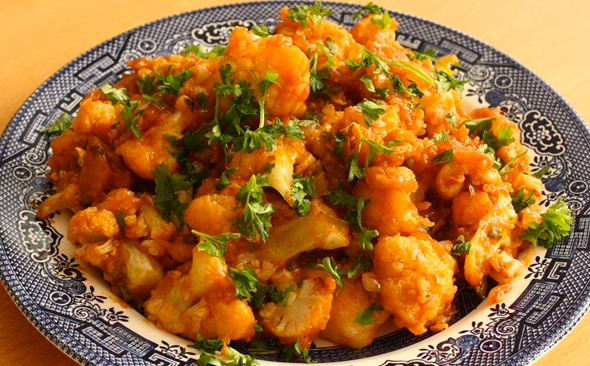Mama’s Punjabi Recipes: Aaloo Gobi di Sabzi (Sauteed Potatoes & Cauliflower)
Like a few other vegetables, phul gobi or cauliflower – or simply gobi – is favored for its versatility to create many dishes. Its tender texture, nutty taste and ease of cooking make it one favorite vegetables in the Punjabi kitchen. The florets can be grated into crumbs and cooked as stuffing for paranthas; sautéed alone or with potatoes, fried in batter as pakoras or pickled with other vegetables.
Another completely Punjabi variation is to cook only the unpeeled central stalk of the gobi (you will need several heads of gobi) or dandal which, when cooked, are quite meaty and tasty.
Many desi restaurants use frozen florets and cook them with chunks of frozen vegetables and serve it with a little sauce, but that is nowhere close to any Punjabi dish that I know. Cooked gobi must be soft but firm, and especially not watery to be delicious.
Some people prefer to add potatoes, especially those little kids who enjoy the taste of potatoes. They only help to add mass to the sabzi, and some people appreciate the way they enhance the taste of the gobi. Still, cauliflower is good for the body as it is rich in calcium, magnesium, potassium and phosphorus as well as vitamin C.
And remember, when making aaloo gobi that is firm, not mushy, make sure to let it cook in its own steam and not to add any water. You do not need to add onions to the aaloo gobi as they only make the dish sweeter and don’t complement the dish.
Ingredients:
1 medium sized phul gobi (cauliflower)
4 medium aaloo (potatoes) – white or red, but not Russet
1 medium piece of adrak (ginger root)
¼ cup tael (olive oil or vegetable oil)
½ tsp haldi (turmeric powder) (too much will make the dish bitter)
Spices (to taste): namak (salt), mirch (red pepper), garam masala, dhania patta (coriander leaves)
Directions:
1. Remove the outer stalks of the gobi and then cut the florets into 1 to 1.5 inch thick pieces. You can even leave small florets whole. If the florets are too big, then some parts of the gobi will cook unevenly and be less done than others. You can even peel the rough central stalk to take out the soft core and put these in the dish.
2. You may peel the potatoes if you want, but if they white or red ones, you can also leave the skin on for extra taste. Wash the cut gobi and aaloo let them drain in a sieve. In the meanwhile, peel the ginger root, cut into small pieces and set aside.
3. Heat the oil in a karai or wok and add the ginger and brown it a little. Add the turmeric and pepper and stir.
4. Now add the cut pieces of gobi and aaloo. Mix well and cover over medium high heat for 5 minutes. Do not open the cover as the gobi and aaloo will cook in their own steam. Stir gently to make sure it does not stick, keep the cover on and then reduce the heat to low.
5. Open the cover just a crack so that any remaining water evaporates and let the gobi and aaloo cook some more for another 5 minutes, stirring occasionally. Be careful not to break the florets.
6. When tender, turn the heat off and sprinkle with garam masala and coriander leaves and leave uncovered for five minutes. Serve with hot rotis or with warm rice and plain yogurt.
MAMA’S TIP OF THE WEEK
TO REDUCE SUGAR, STOP HAIR FALLING, DRINK METHI DANA WATER
Only recently has the Western media been talking about the benefits of vegetables and herbs that have been used in Indian cuisine for centuries. Some of them have even found their way into homeopathic medicine, like karela (bitter gourd) oil and dal chini (cinnamon) pills.
In the same way, methi (fenugreek) has many beneficial qualities, apart from being used in a dish as a tasty complement to potatoes or as stuffing for paranthas. The methi dana (seed) has been shown to help in reducing blood sugar and in weight loss. Simply soak the methi dana in water overnight and then drain the water in the morning and drink it. Powdered methi dana drunk in water is even believed to stop hair from falling and even helping regrowth and thicken hair.

Shakuntla Malhotra is a skilled cook of Punjabi dishes made in the old-fashioned style that she learnt as a young woman in her ancestral home in Lyallpur (since renamed Faisalabad), India before it became part of Pakistan after the Partition in 1947. People have often admired her cooking for its simplicity and taste that comes with each mouthful. Even in her mid-eighties, she continues to cook daily and agreed to share some of her delectable Punjabi recipes.

